| Weight | 1 lbs |
|---|---|
| Dimensions | 9 × 5 × 2 in |
| host | rabbit |
| isotype | IgG |
| clonality | polyclonal |
| concentration | 1 mg/mL |
| applications | IP, WB |
| reactivity | human, mouse |
| available sizes | 10 µL, 100 µL |
rabbit anti-JNK polyclonal antibody 1037
Price range: $100.00 through $2,600.00
Antibody summary
- Rabbit polyclonal to JNK (c-Jun N-terminal kinases)
- Suitable for: IP,WB
- Reacts with: Hu, Ms
- Isotype: IgG
- 100 µL, 10 µL
rabbit anti- jnk polyclonal antibody 1037
| target relevance |
|---|
| Protein names Mitogen-activated protein kinase 8 (MAP kinase 8) (MAPK 8) (EC 2.7.11.24) (JNK-46) (Stress-activated protein kinase 1c) (SAPK1c) (Stress-activated protein kinase JNK1) (c-Jun N-terminal kinase 1) |
| Gene names MAPK8,MAPK8 JNK1 PRKM8 SAPK1 SAPK1C |
| Protein family Protein kinase superfamily, CMGC Ser/Thr protein kinase family, MAP kinase subfamily |
| Mass 48296Da |
| Function FUNCTION: Serine/threonine-protein kinase involved in various processes such as cell proliferation, differentiation, migration, transformation and programmed cell death. Extracellular stimuli such as pro-inflammatory cytokines or physical stress stimulate the stress-activated protein kinase/c-Jun N-terminal kinase (SAP/JNK) signaling pathway (PubMed:28943315). In this cascade, two dual specificity kinases MAP2K4/MKK4 and MAP2K7/MKK7 phosphorylate and activate MAPK8/JNK1. In turn, MAPK8/JNK1 phosphorylates a number of transcription factors, primarily components of AP-1 such as JUN, JDP2 and ATF2 and thus regulates AP-1 transcriptional activity (PubMed:18307971). Phosphorylates the replication licensing factor CDT1, inhibiting the interaction between CDT1 and the histone H4 acetylase HBO1 to replication origins (PubMed:21856198). Loss of this interaction abrogates the acetylation required for replication initiation (PubMed:21856198). Promotes stressed cell apoptosis by phosphorylating key regulatory factors including p53/TP53 and Yes-associates protein YAP1 (PubMed:21364637). In T-cells, MAPK8 and MAPK9 are required for polarized differentiation of T-helper cells into Th1 cells. Contributes to the survival of erythroid cells by phosphorylating the antagonist of cell death BAD upon EPO stimulation (PubMed:21095239). Mediates starvation-induced BCL2 phosphorylation, BCL2 dissociation from BECN1, and thus activation of autophagy (PubMed:18570871). Phosphorylates STMN2 and hence regulates microtubule dynamics, controlling neurite elongation in cortical neurons (By similarity). In the developing brain, through its cytoplasmic activity on STMN2, negatively regulates the rate of exit from multipolar stage and of radial migration from the ventricular zone (By similarity). Phosphorylates several other substrates including heat shock factor protein 4 (HSF4), the deacetylase SIRT1, ELK1, or the E3 ligase ITCH (PubMed:16581800, PubMed:17296730, PubMed:20027304). Phosphorylates the CLOCK-BMAL1 heterodimer and plays a role in the regulation of the circadian clock (PubMed:22441692). Phosphorylates the heat shock transcription factor HSF1, suppressing HSF1-induced transcriptional activity (PubMed:10747973). Phosphorylates POU5F1, which results in the inhibition of POU5F1's transcriptional activity and enhances its proteasomal degradation (By similarity). Phosphorylates JUND and this phosphorylation is inhibited in the presence of MEN1 (PubMed:22327296). In neurons, phosphorylates SYT4 which captures neuronal dense core vesicles at synapses (By similarity). Phosphorylates EIF4ENIF1/4-ET in response to oxidative stress, promoting P-body assembly (PubMed:22966201). Phosphorylates SIRT6 in response to oxidative stress, stimulating its mono-ADP-ribosyltransferase activity (PubMed:27568560). Phosphorylates NLRP3, promoting assembly of the NLRP3 inflammasome (PubMed:28943315). Phosphorylates ALKBH5 in response to reactive oxygen species (ROS), promoting ALKBH5 sumoylation and inactivation (PubMed:34048572). {ECO:0000250|UniProtKB:P49185, ECO:0000250|UniProtKB:Q91Y86, ECO:0000269|PubMed:10747973, ECO:0000269|PubMed:16581800, ECO:0000269|PubMed:17296730, ECO:0000269|PubMed:18307971, ECO:0000269|PubMed:18570871, ECO:0000269|PubMed:20027304, ECO:0000269|PubMed:21095239, ECO:0000269|PubMed:21364637, ECO:0000269|PubMed:21856198, ECO:0000269|PubMed:22327296, ECO:0000269|PubMed:22441692, ECO:0000269|PubMed:22966201, ECO:0000269|PubMed:27568560, ECO:0000269|PubMed:28943315, ECO:0000269|PubMed:34048572}.; FUNCTION: JNK1 isoforms display different binding patterns: beta-1 preferentially binds to c-Jun, whereas alpha-1, alpha-2, and beta-2 have a similar low level of binding to both c-Jun or ATF2. However, there is no correlation between binding and phosphorylation, which is achieved at about the same efficiency by all isoforms. |
| Catalytic activity CATALYTIC ACTIVITY: Reaction=L-seryl-[protein] + ATP = O-phospho-L-seryl-[protein] + ADP + H(+); Xref=Rhea:RHEA:17989, Rhea:RHEA-COMP:9863, Rhea:RHEA-COMP:11604, ChEBI:CHEBI:15378, ChEBI:CHEBI:29999, ChEBI:CHEBI:30616, ChEBI:CHEBI:83421, ChEBI:CHEBI:456216; EC=2.7.11.24; Evidence={ECO:0000269|PubMed:10747973, ECO:0000269|PubMed:10856240, ECO:0000269|PubMed:11062067, ECO:0000269|PubMed:15141161, ECO:0000269|PubMed:16581800, ECO:0000269|PubMed:17296730, ECO:0000269|PubMed:17875713, ECO:0000269|PubMed:18307971, ECO:0000269|PubMed:19166818, ECO:0000269|PubMed:20027304, ECO:0000269|PubMed:21095239, ECO:0000269|PubMed:21364637, ECO:0000269|PubMed:21660049, ECO:0000269|PubMed:21856198, ECO:0000269|PubMed:22441692, ECO:0000269|PubMed:22966201, ECO:0000269|PubMed:27568560, ECO:0000269|PubMed:28943315, ECO:0000269|PubMed:34048572, ECO:0000269|PubMed:8654373}; CATALYTIC ACTIVITY: Reaction=L-threonyl-[protein] + ATP = O-phospho-L-threonyl-[protein] + ADP + H(+); Xref=Rhea:RHEA:46608, Rhea:RHEA-COMP:11060, Rhea:RHEA-COMP:11605, ChEBI:CHEBI:15378, ChEBI:CHEBI:30013, ChEBI:CHEBI:30616, ChEBI:CHEBI:61977, ChEBI:CHEBI:456216; EC=2.7.11.24; Evidence={ECO:0000269|PubMed:10747973, ECO:0000269|PubMed:10856240, ECO:0000269|PubMed:11062067, ECO:0000269|PubMed:15141161, ECO:0000269|PubMed:16581800, ECO:0000269|PubMed:17296730, ECO:0000269|PubMed:17875713, ECO:0000269|PubMed:18307971, ECO:0000269|PubMed:19166818, ECO:0000269|PubMed:20027304, ECO:0000269|PubMed:21095239, ECO:0000269|PubMed:21364637, ECO:0000269|PubMed:21660049, ECO:0000269|PubMed:21856198, ECO:0000269|PubMed:22441692, ECO:0000269|PubMed:8654373}; |
| Subellular location SUBCELLULAR LOCATION: Cytoplasm {ECO:0000269|PubMed:21148294}. Nucleus {ECO:0000269|PubMed:21148294, ECO:0000269|PubMed:30878395}. Synapse {ECO:0000250|UniProtKB:P49185}. Note=In the cortical neurons, predominantly cytoplasmic and associated with the Golgi apparatus and endosomal fraction. Increased neuronal activity increases phosphorylated form at synapses (By similarity). Colocalizes with POU5F1 in the nucleus. {ECO:0000250|UniProtKB:P49185, ECO:0000250|UniProtKB:Q91Y86}. |
| Structure SUBUNIT: Forms a complex with MAPK8IP1 and ARHGEF28 (By similarity). Found in a complex with SH3RF1, RAC1, MAP3K11/MLK3, MAP2K7/MKK7 and MAPK8IP1/JIP1. Found in a complex with SH3RF1, RAC2, MAP3K7/TAK1, MAP2K7/MKK7, MAPK8IP1/JIP1 and MAPK9/JNK2 (By similarity). Binds to at least four scaffolding proteins, MAPK8IP1/JIP-1, MAPK8IP2/JIP-2, MAPK8IP3/JIP-3/JSAP1 and SPAG9/MAPK8IP4/JIP-4 (PubMed:15693750). These proteins also bind other components of the JNK signaling pathway. Interacts with TP53 and WWOX (PubMed:12514174). Interacts with JAMP (By similarity). Interacts with HSF1 (via D domain and preferentially with hyperphosphorylated form); this interaction occurs under both normal growth conditions and immediately upon heat shock (PubMed:10747973). Interacts (phosphorylated form) with NFE2; the interaction phosphorylates NFE2 in undifferentiated cells (By similarity). Interacts with NFATC4 (PubMed:17875713). Interacts with MECOM; regulates JNK signaling (PubMed:10856240). Interacts with PIN1; this interaction mediates MAPK8 conformational changes leading to the binding of MAPK8 to its substrates (PubMed:21660049). Interacts with GRIPAP1 (PubMed:17761173). Interacts with POU5F1; phosphorylates POU5F1 at 'Ser-355'. Interacts with STMN2, STMN3 and STMN4 (By similarity). Interacts with HSF4 (PubMed:16581800). {ECO:0000250|UniProtKB:P49185, ECO:0000250|UniProtKB:Q91Y86, ECO:0000269|PubMed:10747973, ECO:0000269|PubMed:10856240, ECO:0000269|PubMed:12514174, ECO:0000269|PubMed:15693750, ECO:0000269|PubMed:16581800, ECO:0000269|PubMed:17761173, ECO:0000269|PubMed:17875713, ECO:0000269|PubMed:19166818, ECO:0000269|PubMed:21660049}. |
| Post-translational modification PTM: Dually phosphorylated on Thr-183 and Tyr-185 by MAP2K7 and MAP2K4, which activates the enzyme (PubMed:11062067). Phosphorylated by TAOK2 (PubMed:17158878). May be phosphorylated at Thr-183 and Tyr-185 by MAP3K1/MEKK1 (PubMed:17761173). Phosphorylated form is more concentrated at synapses than none-phosphorylated (By similarity). {ECO:0000250|UniProtKB:P49185, ECO:0000269|PubMed:11062067, ECO:0000269|PubMed:17158878, ECO:0000269|PubMed:17761173}. |
| Domain DOMAIN: The TXY motif contains the threonine and tyrosine residues whose phosphorylation activates the MAP kinases. |
| Target Relevance information above includes information from UniProt accession: P45983 |
| The UniProt Consortium |
Data
Publications
| pmid | title | authors | citation |
|---|---|---|---|
| We haven't added any publications to our database yet. | |||
Protocols
| relevant to this product |
|---|
| Western blot |
Documents
| # | SDS | Certificate | |
|---|---|---|---|
| Please enter your product and batch number here to retrieve product datasheet, SDS, and QC information. | |||
Only logged in customers who have purchased this product may leave a review.

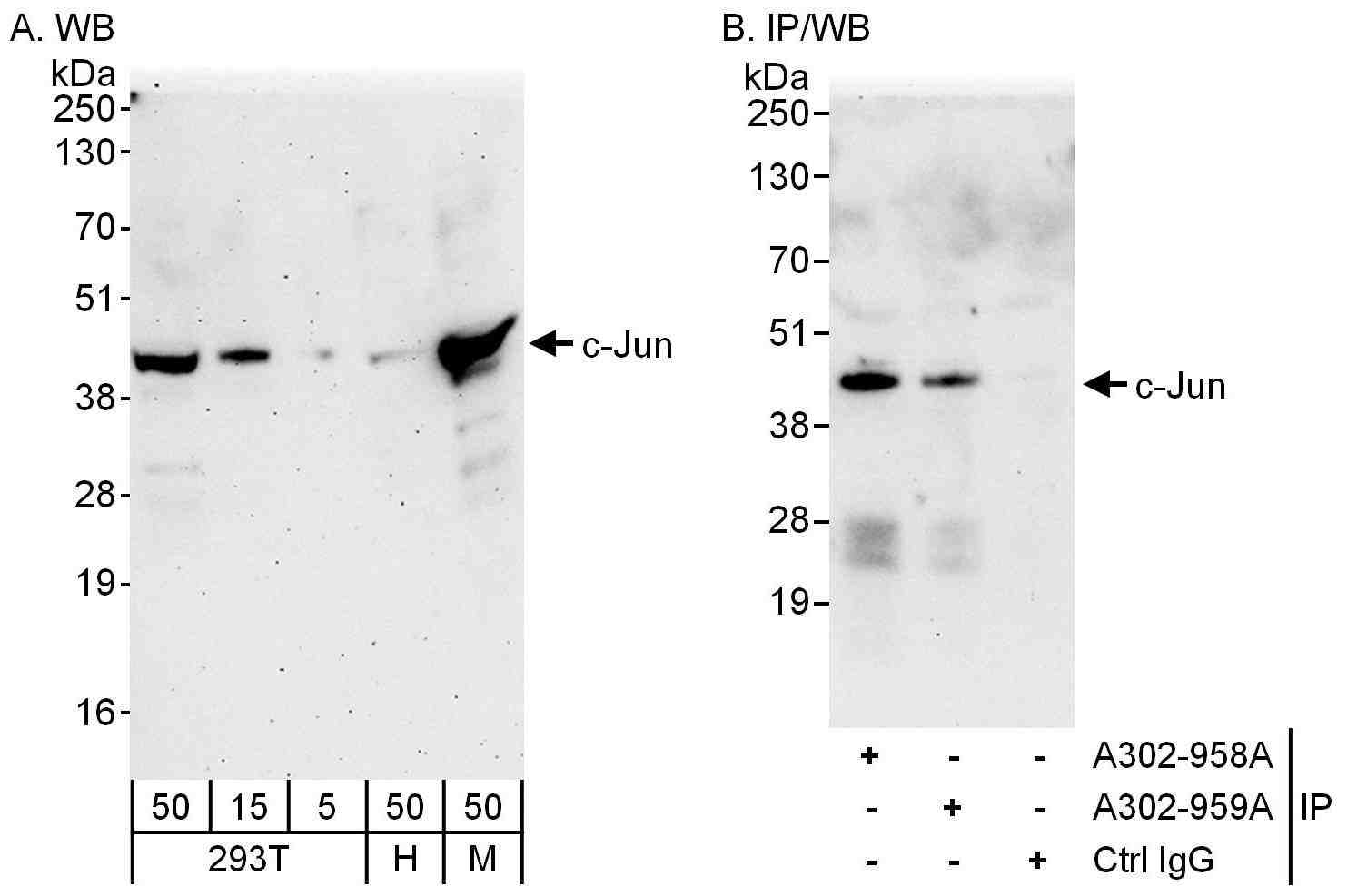
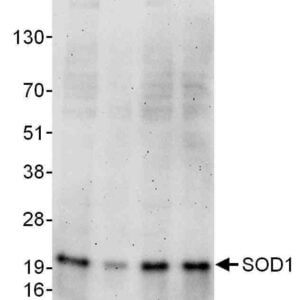
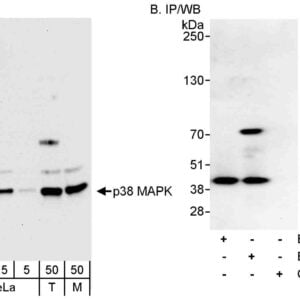
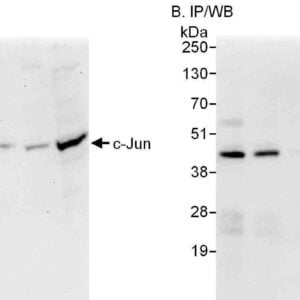
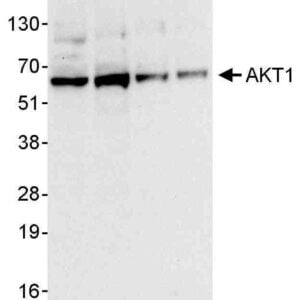

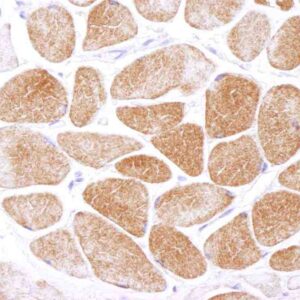
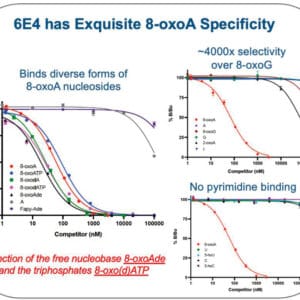

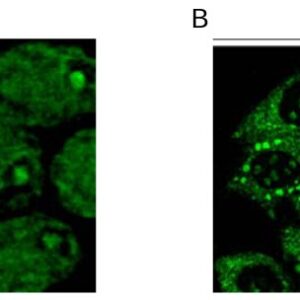
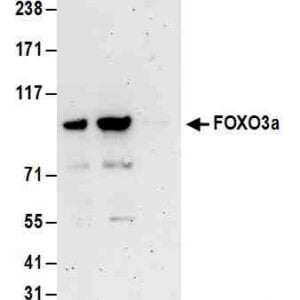
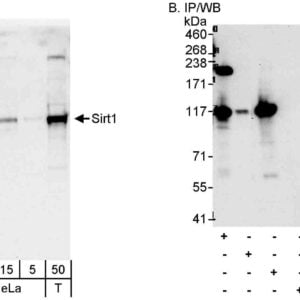
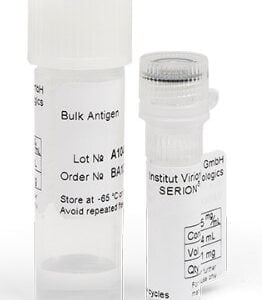
Reviews
There are no reviews yet.